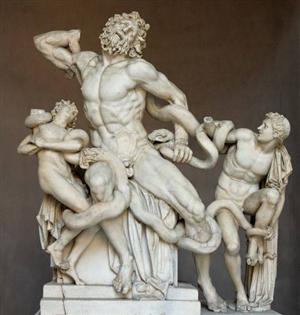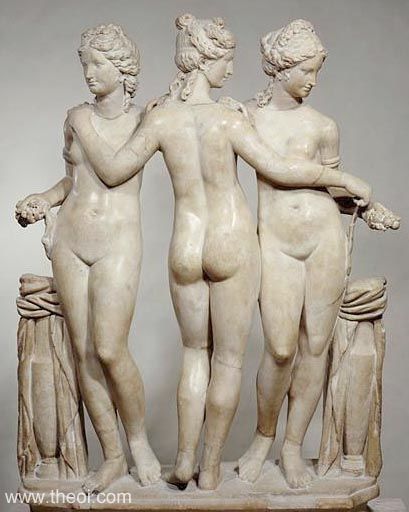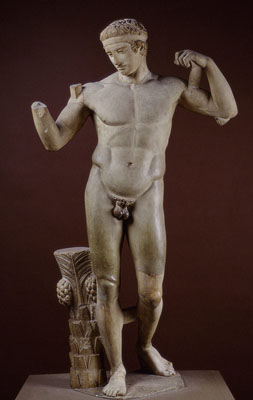Ancient Greek sculptures have a very important place in the history of sculpture as it was greatly influential and laid the foundation for Roman sculptures. Myron, Phidias, Polyclitus, Praxiteles, Scopas, and Lysippus are among the most famous artists in Ancient Greece. Greek sculptures are very important as the vast majority of them tell us a story about Gods, Heroes, Events, Mythical Creatures and Greek culture in general.
By the early 19th century the systematic excavation of ancient Greek sites brought forth a plethora of sculptures with traces of multicolored surfaces. Some of these traces are still visible to the naked eye even today, though in most examples the remaining color has faded or disappeared entirely once the statues were exposed to light and air.
Why was Sculptures important in ancient Greece?
The greek sculptors in ancient Greece were mostly a way to honour the gods. They were displayed In the temples to show the divine character of gods. It was also a way to capture moments from their history. Many times their artists used their imagination to portray the popular myths from the epics. We can gather the themes of their sculptures which showed what was important in their society.
Materials used
The most common materials used for ancient Greek sculptures were marble, bronze or limestone as these were abundant in Greece. Other materials such as clay were also used but due to their brittle nature very few have survived. But cast bronze was the preferred medium and became the most used by the classical period. But for certain statues used mainly in the temples and for luxury works, gold in a leaf form or ivory was used along with gems and other expensive materials.
Ancient Greek through the ages
Geometric Period(10th to 8th century BC)
Archaic period (8th to early 5th century BC)
The archaic period sculptures were greatly influenced by the Egyptian and Mesopotamian techniques of sculpting which made them build statues carved in stone. There was an emphasis on creating perfection in human form. However, most of the statues created during this time period appear very rigid and unnatural.
They reflected a body being assembled in pieces much in the way a mannequin might be created today. Despite the shortcomings, the Greeks were the first to create free-standing statues during this period.
There were almost rigid free-standing statues with their hands being held straight at their sides and even their feet were straight together, with the eyes staring blankly ahead without many expressions. They were almost similar to the Egyptian models with the facial characteristics also beating an eastern touch. There is great detail on the muscles and hairs making their life. The statues always bear an expression known as the archaic smile which gives a sense of aliveness to the figures.
Observing the archaic age figures we see the focus on the human form with the figures of their God like the Apollo figure also having a human form. With time they gave the statues more dynamic movement with some muscular tension and one leg placed just slightly forward. An excellent example of this style is the Kouroi of Argos.
The most common type of figure being sculpted was the nude figure of a standing male, a draped girl in a standing position and another was the seated woman.

Classical period (5th to 4th century BC)
The classical period can be said to be the peak of the Greek civilization where they produced exquisite art, dramas, architecture, scientific inventions and even sculpting.
They made great changes to the style and broke free to make realistic human figures that glorified the nude male torso. Marble was also used in this phase along with bronze which helped them carve statues to their life figures.
Their most common was the depiction of an ongoing action which seemed to be almost captured at the moment. Statues of real people were now being sculpted more in comparison to mythical figures and gods. Famous personalities like Pericles had their statues sculpted and even Olympic champions had their statues.
In this period, using statues and figures as a decorative article on buildings, and temples began to increase. Structures like the Parthenon of Athens, and the temple of Zeus at Olympia used such decorative sites to fill their structures.
The most famous examples of this age were the statue of Zeus at Olympia, and the statue of Athena Parthenos by Phidias are great examples. Discobolos (The Discus Thrower) by Myron in the Museo Nazionale Romano, Rome is also one of the most famous classic Greek statues from this period. Myron’s athlete engaged in the discus throw boasts vigorous and convincing movement in a perfectly made form. His flexing muscles and concentrated expression create the impression of a tightly stretched bow a moment before the string is released.

Hellenistic period (late 4th – 1st century BC)
This period starts near the end of the 4th century and lasts until the Roman invasion in the 1st century. It was during this time that the Greek Statues and Sculpture spread throughout the world as the Greek empire continued to expand. During this period, an even greater emphasis was placed on generating dynamic movement and extreme poses in the art.
The Hellenistic period art became extremely diverse and incorporated many techniques and influences from foreign lands with the conquests of Alexander the Great making Greek culture get in touch with foreign cultures. Great centres of art and architecture flourished in Alexandria, Antioch, Pergamum, etc.
The portrayal of the idealistic form of the human body in the classical shifted to more naturalistic portrayals of humans, especially common people, women, children and even animals. They started portraying more emotions in their sculptures making them seem more realistic rather than idealistic.
Along with the shift towards naturalism, there was also a shift from figures expressing humility to more aggressive and powerful figures. It saw greater demonstrations of energy and power in their figures, a natural outcome of the overcoming of the Greeks of their rivals all over the world under Alexander.
The famous examples of Hellenistic sculptures were the winged victory of Samothrace, the Jockey of Artemision and the Pergamon Altar.

Famous Sculptures from Ancient Greece
Fallen warrior from Aphaia(480BC)
The Pergamon altar(160 BC)
The Riace bronze (420 BC)
God from the sea(470BC)
Marble metope from Parthenon(447 BC)
The Siren vase (480 BC)
The siren vase perfectly captures the scene of Odysseus tying himself to the muddy while his crew plugs their ears to avoid listening to the dangerous songs of the siren which lead the sailors to their death. It brilliantly portrays the agony in his body and the tension in the scene.